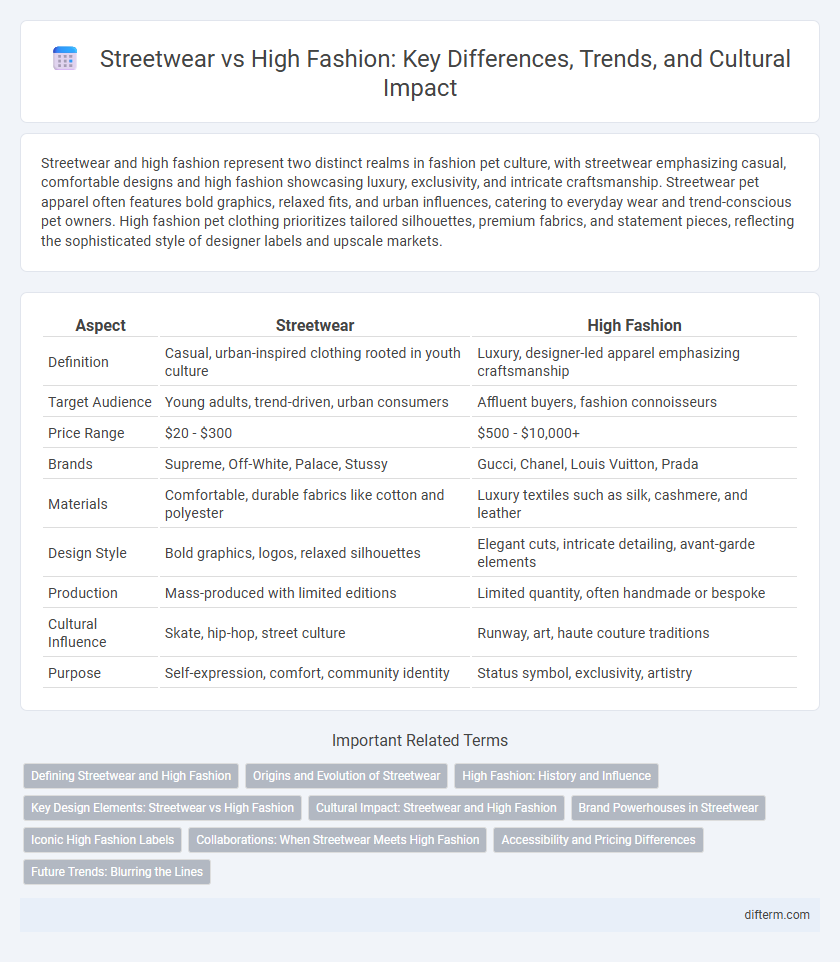Streetwear and high fashion represent two distinct realms in fashion pet culture, with streetwear emphasizing casual, comfortable designs and high fashion showcasing luxury, exclusivity, and intricate craftsmanship. Streetwear pet apparel often features bold graphics, relaxed fits, and urban influences, catering to everyday wear and trend-conscious pet owners. High fashion pet clothing prioritizes tailored silhouettes, premium fabrics, and statement pieces, reflecting the sophisticated style of designer labels and upscale markets.
Table of Comparison
| Aspect | Streetwear | High Fashion |
|---|---|---|
| Definition | Casual, urban-inspired clothing rooted in youth culture | Luxury, designer-led apparel emphasizing craftsmanship |
| Target Audience | Young adults, trend-driven, urban consumers | Affluent buyers, fashion connoisseurs |
| Price Range | $20 - $300 | $500 - $10,000+ |
| Brands | Supreme, Off-White, Palace, Stussy | Gucci, Chanel, Louis Vuitton, Prada |
| Materials | Comfortable, durable fabrics like cotton and polyester | Luxury textiles such as silk, cashmere, and leather |
| Design Style | Bold graphics, logos, relaxed silhouettes | Elegant cuts, intricate detailing, avant-garde elements |
| Production | Mass-produced with limited editions | Limited quantity, often handmade or bespoke |
| Cultural Influence | Skate, hip-hop, street culture | Runway, art, haute couture traditions |
| Purpose | Self-expression, comfort, community identity | Status symbol, exclusivity, artistry |
Defining Streetwear and High Fashion
Streetwear is characterized by casual comfort, graphic designs, and influences from urban culture, often rooted in skate, hip-hop, and youth subcultures. High fashion emphasizes exclusive craftsmanship, innovative design, and luxury materials, typically showcased by prestigious fashion houses during runway shows. The distinction lies in streetwear's accessibility and everyday appeal versus high fashion's emphasis on artistry and status.
Origins and Evolution of Streetwear
Streetwear originated in the 1970s and 1980s as a grassroots movement rooted in skateboarding, hip-hop culture, and punk music, blending comfort with urban expression. Its evolution was shaped by influential brands like Stussy and Supreme, which transformed casual, accessible apparel into coveted fashion statements. The rise of social media and collaborations with luxury houses accelerated streetwear's integration into high fashion, redefining contemporary style norms.
High Fashion: History and Influence
High fashion originated in 19th-century Paris with couturiers like Charles Frederick Worth establishing exclusive, custom-made clothing that set the foundation for modern luxury brands such as Chanel and Dior. Its influence extends globally, shaping cultural standards, inspiring streetwear trends, and driving innovation in fabric technologies and garment craftsmanship. The category continuously evolves by blending traditional techniques with avant-garde design, cementing its role as a symbol of status and artistic expression.
Key Design Elements: Streetwear vs High Fashion
Streetwear emphasizes bold graphics, oversized silhouettes, and utilitarian details like patches and zipper accents, reflecting urban culture and casual comfort. High fashion prioritizes intricate craftsmanship, luxurious fabrics, and avant-garde shapes that push creative boundaries and showcase exclusivity. The contrast lies in streetwear's functional practicality versus high fashion's focus on artistic innovation and refined tailoring.
Cultural Impact: Streetwear and High Fashion
Streetwear has revolutionized cultural expression by merging urban artistry with mainstream fashion, influencing music, skateboarding, and youth culture globally. High fashion preserves heritage and craftsmanship while setting luxury trends that often draw inspiration from streetwear's grassroots authenticity. Both spheres continuously shape societal values and identity through distinct yet interconnected cultural narratives.
Brand Powerhouses in Streetwear
Brand powerhouses in streetwear like Supreme, Off-White, and A Bathing Ape have revolutionized urban fashion by blending casual aesthetics with exclusive drops and high demand, driving immense cultural influence. These brands leverage limited editions and collaborations with luxury designers, creating a unique intersection between streetwear and high fashion that fuels consumer desire and resale values. Their strategic use of social media and celebrity endorsements amplifies brand visibility, solidifying their foothold as dominant players in the contemporary fashion landscape.
Iconic High Fashion Labels
Iconic high fashion labels such as Gucci, Balenciaga, and Louis Vuitton set the standard for luxury and exclusivity, often blending artisanal craftsmanship with cutting-edge design. These brands consistently influence global fashion trends through runway shows and celebrity endorsements, reinforcing their status as symbols of prestige. Unlike streetwear, which thrives on casual comfort and urban culture, high fashion emphasizes opulence and meticulous attention to detail.
Collaborations: When Streetwear Meets High Fashion
Collaborations between streetwear brands like Supreme and Off-White with high fashion houses such as Louis Vuitton and Balenciaga have revolutionized the fashion landscape by blending urban culture with luxury craftsmanship. These partnerships generate limited-edition collections that create high demand and elevate the status of streetwear within the luxury market. The fusion of bold graphics, casual silhouettes, and premium materials attracts a diverse audience, driving sustained growth in both sectors.
Accessibility and Pricing Differences
Streetwear brands such as Supreme and Off-White offer more accessible pricing, typically ranging from $50 to $300, making them popular among younger demographics and urban consumers. High fashion labels like Gucci and Balenciaga command significantly higher prices, often exceeding $1,000 for basic items, reflecting exclusive craftsmanship and luxury materials. The accessibility gap affects market reach, with streetwear leveraging mass appeal and high fashion maintaining exclusivity through limited availability and premium pricing.
Future Trends: Blurring the Lines
Streetwear and high fashion continue to converge, with designers integrating casual aesthetics and luxury craftsmanship to create hybrid collections that appeal to diverse consumer bases. Innovations in sustainable materials and digital fashion, including virtual try-ons and NFTs, drive this fusion, reshaping how brands engage with younger, tech-savvy audiences. Collaborations between established luxury houses and streetwear brands signal a future where traditional fashion boundaries dissolve, fostering inclusive, multifaceted style expressions.
streetwear vs high fashion Infographic

 difterm.com
difterm.com